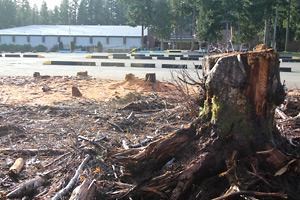Residents are offering suggestions to City of Powell River officials about what to do with a logged area at Powell River Recreation Complex.
In June, the area was logged in preparation for constructing an athletic track. After Great Blue Heron nests were discovered, logging stopped and the track was relocated to Timberlane Park. The area was cleared of the downed logs in September, after the heron chicks had fledged.
City staff has suggested uses for the cleared area, including a bike park, adult recreation activities, basketball court and expanding the parking lot, as well as reforesting the entire site. Council directed staff to cost out the potential uses.
At the December 2 committee-of-the-whole meeting, a group of students from Kelly Creek Community School made a presentation asking that the city establish a mountain bike park on the cleared area. Kolton Fuller spoke for the group, all members of a mountain bike club at the school. He said the number of places where youth can ride is limited and safety is an issue. A bike park would be safe, central and promote skills development. He asked that the city hire Jay Hoots, a professional rider and bike park designer, to design a skills park for the area. Hoots recently visited Powell River and met with city staff and several members of the Powell River Cycling Association.
Staff reported that a skills bike park would cost about $275,000. An outdoor fitness area would cost about $34,000, an outdoor basketball court, $36,000 and an expanded parking lot, $10,000. Staff also reported it would cost about $35,000 to remove tree stumps in the area.
At the December 16 committee-of-the-whole meeting, councillors discussed a letter from the Malaspina Group of the Sierra Club of Canada, written by Betty Zaikow. She wrote that the club would like to see the nesting area replanted with trees as soon as possible to restore the area for Great Blue Herons, as well as many other bird species that use the area for nesting. “The original walking path and trail should be restored,” Zaikow wrote. “Under no circumstances should this park area [be] used for anything other than a natural preserve.”
Councillor Dave Formosa recommended that the city speak to a bird expert to find out if an activity area at the site would jeopardize the herons. “I would like to know if we build this thing, are those birds going to be okay?” he said. “I’d hate to see this thing come flying back.”
Stan Westby, the city’s chief administrative officer, assured councillors that Bill Reid, director of parks, recreation and culture, was already checking that. “He’s looking into making sure that we have all clearances in place before he makes any recommendations,” Westby said.
Councillor Debbie Dee suggested the city reply to Zaikow and explain staff is taking into consideration the herons and council won’t make any decisions until they have that information.
Staff, meanwhile, is also researching grant opportunities to see if funding is available for the suggested uses.
In particular, council directed staff to provide a report about the provincial government’s Towns for Tomorrow program for the suggested recreation activities at the complex, as well as sidewalks, trails and bike lanes development. Staff had recommended submitting an application to the program for road improvements.



